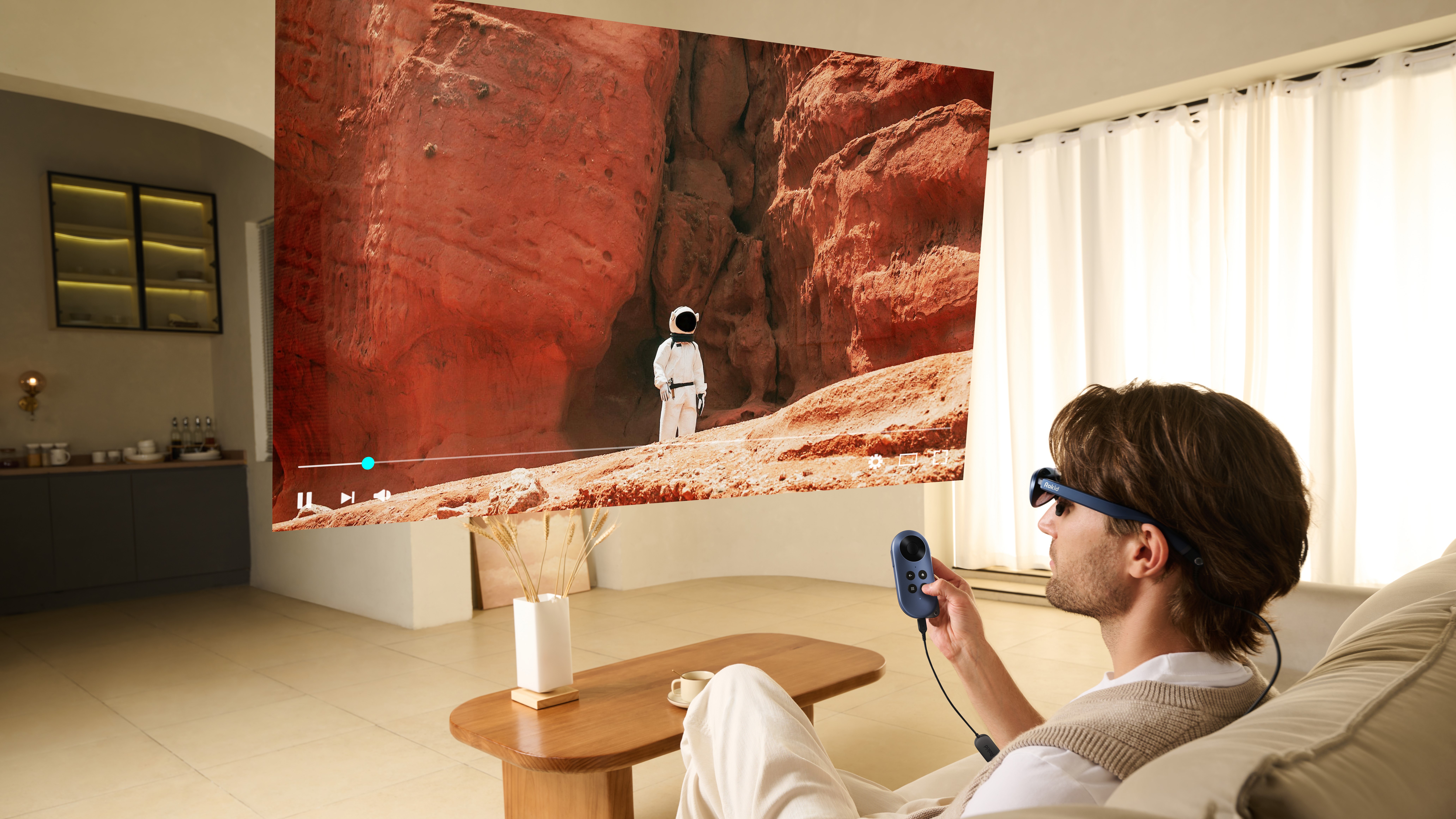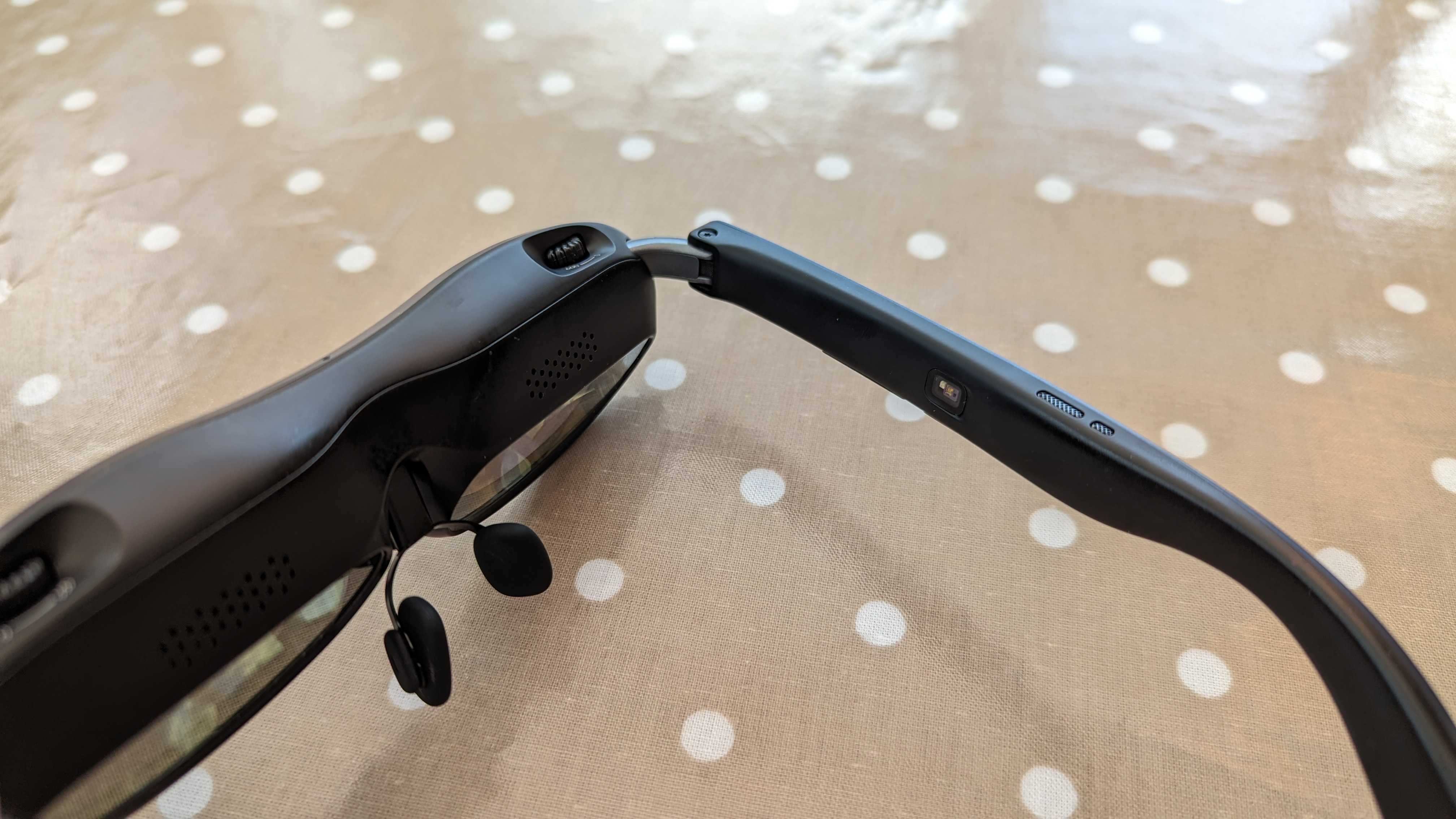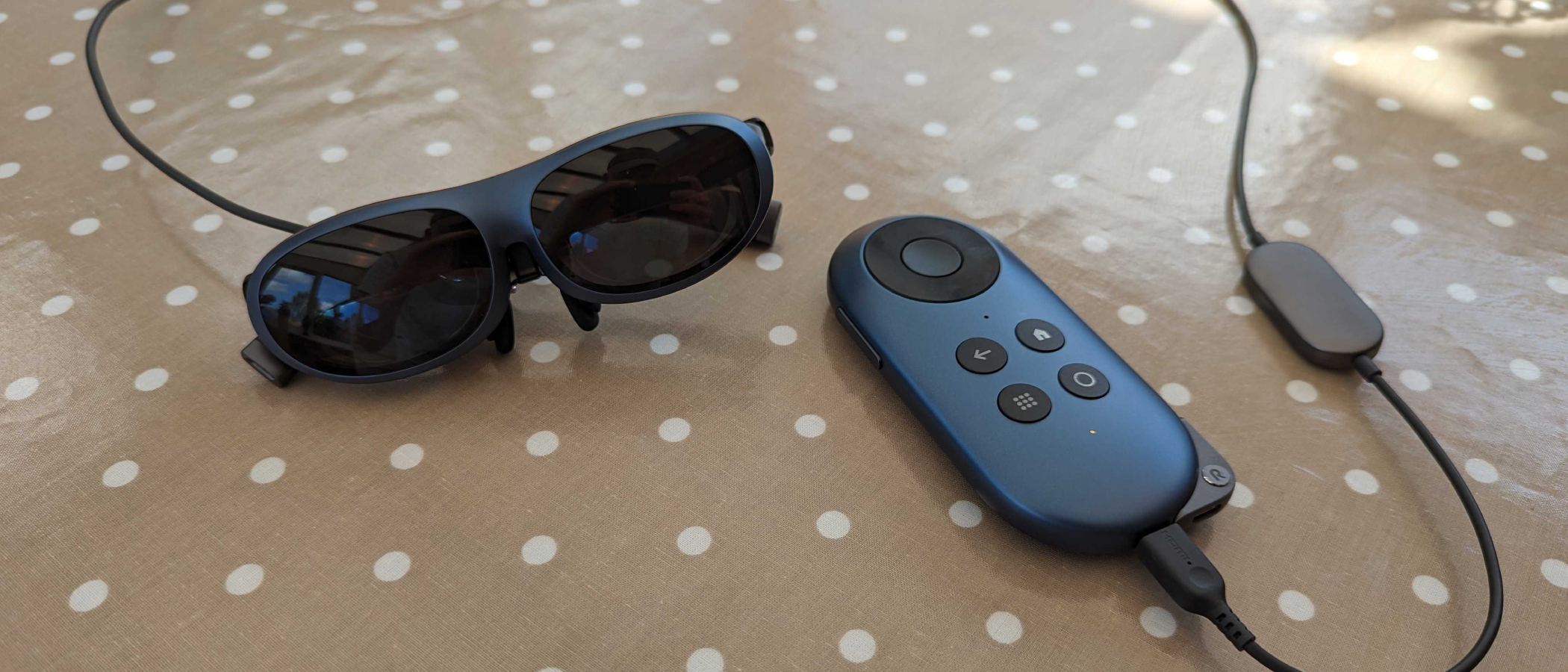TechRadar Verdict
The Rokid Max AR glasses are what I’ve come to expect from smart specs. The image quality is fine, the audio is okay, and the design is lightweight – though all of these aspects have faults that I’ve seen from its rivals.
Pros
- +
Decent HD picture
- +
Max Station is simple
- +
Compact
Cons
- -
Weak audio
- -
Pricey
- -
Get uncomfortably hot
Why you can trust TechRadar
Rokid Max AR glasses: One minute review
The Rokid Max AR glasses are par for the course when it comes to AR glasses. They offer a lightweight wearable second screen for compatible devices, effectively providing you with a private, portable home theater. They’re not perfect, though.
I'm not a fan of the glasses' design overall, but one major negative aspect of the design isn’t just down to my personal tastes. The bridge of the glasses – the part pressed up against your face – gets hot. It never burns, but it is unpleasant, and the glasses heat up fairly quickly.
Picture-wise, the Rokid glasses are fine – roughly on par with a decent budget projector. This means you’ll get fairly vibrant colors when the brightness is turned up to max, but you’ll need to use the optional lens cover or use them in a dark environment for the best visuals. No matter your setup, contrast in dark scenes is weak, with onscreen details of scenes in shadow or set at night losing any intricacy.
Similarly, audio is passable, but the Rokid Max’s inbuilt speakers lack any kind of force in the bass department, so expect your favorite film score to sound less impactful than you’re used to. There’s also a fair amount of audio leakage, so unless you want everyone around you to hear what you’re watching, we’d recommend using headphones – though headphones aren’t usable with the Rokid Station.
Speaking of the Rokid Station, this add-on may be officially optional, but I’d recommend picking it up if you can. It turns the glasses into a portable Android TV (with a roughly five-hour battery life), giving you access to a host of streaming services. You can also cast videos from your phone to it just like you would with a Chromecast.
Lastly, the Rokid Max AR glasses are slightly more pricey than some of their rivals – such as the Xreal Air glasses – and I don’t feel they offer a better experience for the money. During sales, you've previously been able to pick up a bundle of the glasses and Rokid Station at a reasonable price, so I’d recommend waiting for a deal before buying a pair.

Rokid Max AR glasses: Price and availability
The Rokid Max AR glasses usually cost $439 – they’re currently only available in the US unless you ship them internationally – though at the time of writing, they’re on sale for $399 at Amazon.com and the official Rokid store. Both prices are in the same ballpark as similar AR glasses, however, they’re at the higher end of the scale. The Rokid Max glasses cost more than rivals like the Xreal Air AR glasses (at $379) and don’t offer a compelling enough reason to consider them over the competition.
Sign up for breaking news, reviews, opinion, top tech deals, and more.
The Rokid Station is an optional add-on (which we’d recommend you pick up with the glasses as they turn it into a standalone Android TV) for $129. Though at the time of writing, the Max and Station can be bought in a bundle for $489, saving you $89. This deal won’t be around forever, but always look out for similar sales, as it’s hard for us to recommend these smart specs at full price. As a pair – at the discounted price – the Rokid Max and Station are a formidable duo compared to the competition, offering simplicity and good performance at a relatively decent price.
In general, we’ve found AR glasses feel a little too much like an early adopter’s gadget. By that, we mean that the price you pay is high for what you get. While they do serve slightly different purposes, it’s hard not to compare AR glasses to a VR headset like the Oculus Quest 2 – which costs as little as $299 and offers considerably more bang for your buck.
- Value score: 3/5
Rokid Max AR glasses: Performance
- Colors look vibrant with max brightness
- Struggles with shadowy scenes
- Sound lacks fullness and oomph
The image quality from the Rokid glasses is comparable to a decent budget projector – fine but not faultless.
With the Rokid Max AR, I could enjoy full-HD (1080p) video on a virtual 210-inch screen, which is pretty awesome when just lying back in my bed. In a dark environment, the picture looks solid with decently vivid colors – though I’d recommend setting the brightness to max for the best image. If you’re in a brighter environment, the black cover is a must, as you'll struggle to see what’s happening without it.
Unfortunately, as is the case with other AR glasses, these specs struggle to reproduce dark scenes with clarity. Watching the finale of a film like Spider-Man: Homecoming – where our protagonist faces off against a villain with a dark costume in a dingy warehouse at night – making out details is a challenge. Characters’ facial expressions were sometimes impossible to see when they were in shadow, and the villain’s costume and glider just looked like dark blobs rather than intricate designs.

A minor annoyance is that the screen can become somewhat blurry at the edges. Generally, this isn’t a problem as the action is in the middle of the screen, but details on the fringes won’t be in focus, which can be an immersion-breaking distraction when you’re trying to enjoy a show.
Audio-wise, the Rokid glasses are passable in terms of mid and higher-range tones, but the bass lacks any kind of oomph to it. That said, if you’re planning to use them for film and TV rather than music videos you should be fine, just expect your favorite scores to sound a little more flat and emotionless than you're used to.
Additionally, audio does leak a considerable amount at moderate to loud volumes, so if you're using the Rokid Max AR glasses in a public space (like on a train during your commute to work), then you need headphones – though headphones will only work if you connect the glasses to your phone, using the glasses and station means you’re forced to use the in-built speakers.
- Performance score: 3.5/5
Rokid Max AR glasses: Design
- Fit really well
- Not my favorite design aesthetically
- Get uncomfortably hot
Design-wise, the Rokid Max AR is a mixed bag, with some factors I love and others that are disappointing.
On the positive end, I love the fit of the glasses. They’re comfy to wear at just 75g and come with two interchangeable nose clips. What’s more, they offer 0.00D to -6.00D myopia adjustment wheels for each eye, and you can buy an optional lens attachment at a fairly decent price (the site says they’re usually $30, though I’ve seen them on sale for $15) if you need a bigger adjustment. Ideally, this lens clip would be free, as you also need to provide your own prescription lenses, but at least it’s there if you need it. Not every pair of AR smart glasses is as accessible for prescription glasses wearers.
On the negative end, they suffer the same major design issue I found with the TCL Nxtwear S glasses; the bridge (which is pressed up against your face) gets hot when the device is in use, rather than an outer edge that's not against your skin as with the Xreal AIr glasses. The heat was never painful, but it did get uncomfortable, especially during the hot weather we were experiencing in the UK while I was testing these out.
I also think the glasses are pretty ugly with their bug-eyed look and choice of blue plastic covering. This just gives me an excuse to never remove the optional cover, as it gives the glasses a nicer shape (at least to me).

Lastly, while the case is annoyingly close to being perfect, it falls short and is still kind of a failure. Yes, it’s great storage for the glasses and its cables but, ideally, it would also store the Rokid Station. There’s a perfect slot in the base of the case for the station – it fits so precisely that this must be intentional – but then there’s only space to fit the glasses too, and no room for the necessary connector cable that attaches the two pieces together.
I tried shoving everything in to see if it could work but ended up breaking the zip – it’s fixed now, thankfully. No other AR case included with the glasses I’ve tested offers the ability to carry the glasses and adapter in a single pouch; I was hoping Rokid would be different, but I’ve been disappointed again. Maybe a future iteration will finally fix this frustrating problem.
- Design score: 2/5
Rokid Max AR glasses: Compatibility
- Compatible with devices that support Display Port over USB-C
- Rokid Station is easy to use
The Rokid Max glasses are par for the course in terms of compatibility. If your gadget supports Display Port over USB-C, then you can plug these specs in and use them as a second screen. This includes many laptops, smartphones (such as the Samsung Galaxy S23), and even the Steam Deck. To be able to hook up other devices like a Nintendo Switch, PS5, iPhone 14, or PC with only HDMI-out you’ll need to buy additional adapters, which Rokid sells for around $40 each.
You could also pick up the Rokid Station to turn your smart glasses into a smart TV powered by the Android TV OS. This little AR smart glasses hub is really neat and one of the easiest to use that I’ve tested. Once you’ve logged in with your Google account, you can download a range of apps for the best streaming services – including Netflix and Disney Plus. Alternatively, using the in-built Chromecast, you can cast videos from your phone to the Station.
The advantage of this is that your glasses will use the Station’s five-hour battery rather than your smartphone’s. You can even charge the Station while using it, so you can endlessly enjoy your favorite streamed content.

Should you buy the Rokid Max AR glasses?
| Attribute | Notes | Score |
|---|---|---|
| Performance | These glasses perform fairly well visually compared to other AR glasses, though shadowy scenes don't have a lot of clarity and audio is not great. | 3.5/5 |
| Design | The glasses get uncomfortably hot against your face so while the design has many fine qualities it's a struggle to rate it higher than a two out of five. | 2/5 |
| Value | All AR glasses are a bit pricey, and are all around $400 just like the Rokid Max AR glasses, so a middle of the road score seems fair. | 3/5 |
Buy it if...
You have a compatible device
These glasses are only really worth it for people with compatible devices, or who have purchased the Rokid Station. If you have a few, then you might want to think about picking a pair up.
You commute a lot or have a small living space
If you’re often riding on a train for work or your living space at home is small, AR smart glasses are a great way to get a big-screen experience for streamed and downloaded films and TV in a small lightweight package. The Rokid Max is no exception.
You love new tech
AR smart glasses like the Rokid Max specs are still fairly new, and there's an excitement that comes with using tech not a lot of people have. Sure they have faults, but there's something undeniably fun about wearing a home theater on your face.
Don’t buy it if...
You’re on a tight budget
AR smart glasses like these aren’t cheap, and what makes them even more pricey is that you really need the Rokid Station add-on (and other optional adapters) to get the most out of them. If you’re on a tight budget, the Rokid Max glasses aren’t for you.
You demand excellent performance
HD resolution and mediocre audio aren’t everyone’s bag, especially now that 4K and decent soundbars are relatively affordable. If you want a high-quality entertainment experience then these glasses don’t offer quite what you want.
You can't stand the heat
These AR glasses can get uncomfortably hot fairly quickly. It's not painful, but it can ruin the experience for some.
Also Consider
Meta Quest 2
The Meta Quest 2 won’t offer the portable TV experience you'll get from these Rokid specs, but it still remains our top recommendation for those looking to enter the early metaverse powered by AR and VR gadgets.
Read our full Meta Quest 2 review
Nreal Air AR Glasses
While the Nreal Air glasses suffer from some of the same issues as the Rokid AR glasses (mainly the high price and image quality) we found the design and the performance of Nreal's glasses to be better overall.
Read our full Nreal Air AR Glasses review
TCL Nxtwear S AR glasses
The TCL Nxtwear S glasses are very similar to the Rokid Max specs, with the biggest difference being the more clunky adapter hub it uses compared to the Rokid Station. But if this is on sale, it might be one to consider instead of Rokid's Max.
Read our full TCL Nxtwear S review
How I Tested The Rokid Max AR glasses
- Used for a couple of weeks
- Tested with a range of devices
To test out these AR smart glasses, I used them for a couple of weeks in my home – using them as a second screen for a laptop, smartphone, and the Rokid Station. This was to get a feel for how easy they are to use with a selection of compatible gadgets.
I also made sure to watch a range of content types through the glasses, including music videos, movies, and YouTube videos, to understand the audio and visual capabilities of the Rokid Max glasses. In particular, I made sure to listen to bass-heavy music and very visually dark content, as these can be challenging for AR glasses. During my tests, I also made sure to watch the same content multiple times to get a sense of the glasses' performance with and without the cover in rooms of varying brightness.
[First reviewed September 2023]

Hamish is a Senior Staff Writer for TechRadar and you’ll see his name appearing on articles across nearly every topic on the site from smart home deals to speaker reviews to graphics card news and everything in between. He uses his broad range of knowledge to help explain the latest gadgets and if they’re a must-buy or a fad fueled by hype. Though his specialty is writing about everything going on in the world of virtual reality and augmented reality.



